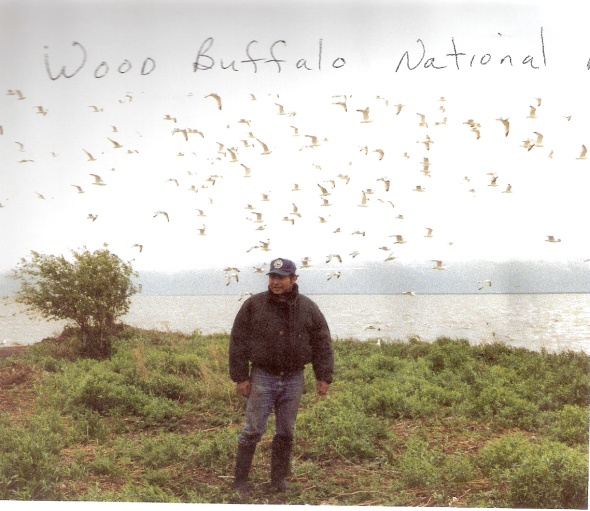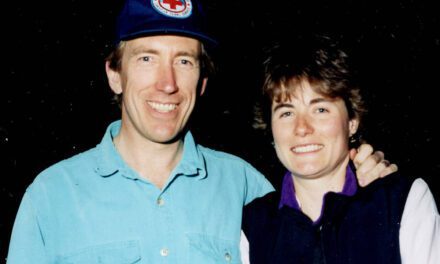(24:33) To tell you the truth, I thought that I was going to work until I was 65. (In response to the question, “Is there anything that you didn’t really like about the service?”) I loved going to work every day, there was not a day when I didn’t get up and want to go to work, you know what I mean? It was an easy job, an easy job to go to. For sure, I really liked it. (In response to the comment, “That is a great thing to be able to say.”) I don’t think there is anything about it that I didn’t like. It was a fair organization at the time. If you got promoted, you got promoted on merit. When you interviewed, the hiring people looked at references, you got honest references. The wardens were generally pretty good people…
(25:56) Yeah, I guess Nahanni. (In response to the question, “Of all the parks you worked in, was Nahanni your favorite?”) I liked Nahanni, it was really good. I was there at the right time, I was young and could do everything. I also really liked it out at Saskatchewan, I liked Grasslands. I really liked that, I wasn’t there long enough. And Jasper, I would have liked to have been longer in Jasper. I can’t really say that I didn’t like any of them, you know what I mean? Wood Buffalo was a different park. It was a very, very big park, 15 000 square miles, that is bigger than all the mountain parks put together, so you couldn’t get to know it as intimately. But it was a neat park too, a lot of history…
(28:00) A lot of interesting things happened along the way. (In response to the question, “What were some of the more memorable events of your warden service career?”) I know one good story that I could tell you, it was when we were in Nahanni. There weren’t very many white guys there at the time and we had gone across the river to visit with the school teacher. We had been playing cards and we were coming back that one night. We had a little scow, a wooden boat. It was me and Cheryl and the two kids. It was dark and anyway on the way back I hit a sweeper. A log that sticks out of the water. It punched a hole in the boat. I remember Cheryl was wearing this heavy knitted sweater and I asked her for her sweater and it was cold eh? I got her sweater off her and I plugged the hole with her sweater because it was pouring in on my side, the right side. Cheryl has always wondered why I didn’t use my own jacket! Yeah, it was just across the river, the river was about half a mile wide. (In response to the question, “Was it a short ride?”) We didn’t make it to the station; we made it to a sandbar farther downstream. We pulled the boat up on shore and walked home. It’s a good little story!
(30:11) Oh for sure! (In response to the question, “But you would say Cheryl enjoyed the warden life?”) No, she learnt along the way. (In response to the question, “Did she grow up riding horses?”) She learned how to drive a boat and run a skidoo…She never complained, that I can really remember… (Cheryl refers to this incident in Ann Dixon’s book Silent Partners saying, “We started home in the scow and hit and underwater log. Next thing we knew we were standing in water and it was coming in fast. Lou hollered for my sweater to plug up the hole. By this time the kicker quit as the motor got wet, so we paddled to shore. We got home hours later from a trip that usually took ten minutes. We were thankful for still being alive. Today I wonder: “What was wrong with Lou’s sweater, why mine!” (pg.140)
(31:35) Where I was at the time they still had districts. (In response to the question, “How did the warden service change over the years?”) But they were phasing out guys who would stay out on the district all winter…especially in Banff and Jasper…When I got on there wasn’t any of that, I don’t think. We lived out on warden stations, especially in Riding Mountain, there are quite a few warden stations around the park where you were stationed on the boundary of the park, probably 30 or 40 miles from a town. Nahanni was very isolated. In Wood Buffalo the wardens either lived in Chip or they lived in Fort Smith and they would go out on ten day patrols. Well no, there was only me and another warden…(In response to the question, “Were there districts in Nahanni?”) At the end I had two GT2s, but at the start there was only one. Then in the summertime we would hire some seasonals. The way that the warden service changed, that I could see is the warden service used to spend a lot of time in the backcountry. That was either in Banff or Jasper, Riding Mountain, Wood Buffalo or wherever. By 1995, the emphasis was starting to change. They wanted to shut down more of the districts. Before 1995, they moved the people out of Nahanni, Fort Simpson. In Riding Mountain they were starting to close the warden stations…I was just talking to Art Cochrane a couple of days ago. He lives in Manitoba just outside the park. When I was in Riding Mountain we wintered anywhere from 24 to 28 horses. Right now I think that they are wintering about seven and none of them are being used. A lot of the warden stations are closed. The backcountry is probably not getting covered at all, or looked at. But you know, parks are still there…I am not sure if it is 100% bad. You know what I mean? It is probably not good, but it is probably not real, real bad when you stand back and look at it…The other piece is visitation. In Parks that has changed too. And poaching, the concept of poaching has changed. Like in Riding Mountain, it was a big deal there was active poaching almost every month of the year. They don’t do that anymore. Elk and moose. (In response to the question, “In Riding Mountain, what were people poaching?’) Obviously the farmers next to the park would probably kill an elk or two, because they fed a lot of them during the winter and they ate them. (In response to the question, “Was it for food?”) But there was a lot of animals being shot and sold, especially into Winnipeg and that was just for food. But I don’t think it goes on as much anymore. When I was in Nahanni for instance we were really active on the rivers. We would have usually at least two or three drownings every year and we would have some rescues to do. We didn’t have that much visitation, maybe 800 to 1000 canoeists; it was a tough river to canoe. Now there are not that many people canoeing the river, so they probably don’t have to be on the river as much. Another thing is and some people may take offense to this, but we spend a lot of money monitoring game populations…counting buffalo, counting elk, counting this, counting that…If one year the elk population in Riding Mountain was 5000 and the next year we counting and it was 2500. Are we going to do anything about it? Are we going to go out and shoot wolves? Not likely, so maybe we didn’t need to be counting the elk that much. Yeah they did…but by the mid 1970s they quit all that. (In response to the question, “In Banff I think they had the opposite problem, there was too many elk. Didn’t they have the elk slaughters?”) I don’t know the exact date when they finished doing that and they let populations basically fluctuate, do whatever they need to do. It is the same in Wood Buffalo, sometimes we’ve had 10 – 15 000 buffalo in the park. Right now, I bet you maybe this year there are 3000. I think our management actions are probably going to be fairly limited, unless we are dealing with an endangered species or something like that, which we did deal with the peregrine, the whooping cranes and stuff like that.

Patrolman Johney Courteraie – Wood Buffalo National Park



